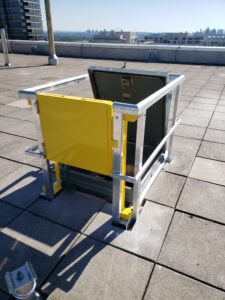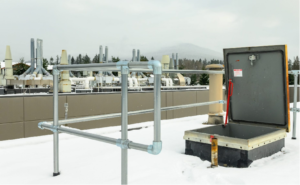There are many reasons why you would want to visit your commercial or industrial rooftop during the winter months. Whether the motivation is to conduct maintenance, make repairs, or install new equipment, championing safety when working at heights is always a primary focus.
 True roof safety begins from the ground up. It starts before you even step foot on the roof, by ensuring anyone who has access to the roof of the building is properly trained and aware of all the potential risks. Rooftops differ from one another, so understanding how to go about navigating your rooftop safely is critical, requiring a routine review of your roof layout. Furthermore, it is recommended to constantly assess risks that are identified on your roof layout, and the actions taking place to mitigate such hazards.
True roof safety begins from the ground up. It starts before you even step foot on the roof, by ensuring anyone who has access to the roof of the building is properly trained and aware of all the potential risks. Rooftops differ from one another, so understanding how to go about navigating your rooftop safely is critical, requiring a routine review of your roof layout. Furthermore, it is recommended to constantly assess risks that are identified on your roof layout, and the actions taking place to mitigate such hazards.
“Roof safety begins by taking stock of what you’re doing now and identifying where you need to improve,” agrees Vernon Ghinn, Vice President of Sales with the Skyline Group Intl.
It’s equally important to verify that the means of accessing your rooftop are as safe and secure as the roof environment itself. This includes reviewing the hatch ladders and outdoor access ladders that are required to be designed and manufactured to both provincial and federal safety standards.
“It’s imperative that the ladder is well made and code compliant,” Ghinn continues. “That means it starts off within 12 inches of the ground, that the distance from the back of the ladder to the exterior wall falls within regulations, and that the ladder includes a ladder door or panel to restrict unauthorized access and further prevent falls.”
An access ladder’s height will also trigger safety considerations. For example, if the ladder is greater than ten feet, it’s good practice to have guardrails on either side when stepping off of the ladder onto the rooftop, directing the climber past the danger zone, helping to prevent an accidental fall once stepping onto the roof.
Restricting unwanted access
It’s possible, with even good intentions, to create a fall risk or hazard when looking to create a safer climb for your maintenance team. For example, property managers and consultants may be tempted to cut the bottom 5+ feet of their outdoor building access ladder to prevent unauthorized personnel from climbing. Doing so, however, creates severe safety risks and liability for property owners.
Even still, says Vincenzo Cutrone, Marketing Manager with Skyline Group, “cutting ladders short is a common site-related hazard that adds an unneeded risk of a fall for those who have the approval to climb the ladder. Imagine being required to take an 8-foot step ladder to climb onto a caged or lifeline ladder. That process of stepping off one ladder to the access ladder is simply dangerous. While still not removing the risk of unauthorized access.”
A better way to restrict access, Cutrone offers, is to install a lockable ladder door/panel, or a cage gate if you have a caged ladder.
Mind the hatch
Some buildings may enable access to their roof through a roof hatch. In this case, it’s important to ask yourself a few questions:

- Do the side rails of the ladder extend through the roof hatch door in order to maintain your three points of contact while stepping onto the roof?
- Once on the roof, is there a hatch barrier around the hatch with a self-closing gate that will close behind me, thereby eliminating the risk of a fall?
- Is the roof hatch close to the roof edge? If so, is a guardrail system installed to remove the risk of a fall?
Reaching the top
Accessing the roof is only the first step. The next step is ensuring that everything is being done to mitigate slip and fall risks while navigating the roof.
Says Ghinn: “The first thing we ask when it comes to roof safety is: What is the roof type that I’m standing on? Is it slippery? Is it easy to navigate with my footwear? What about HVAC equipment, ducting, or piping? Is this a green roof with vegetation? Or does it include various solar panels? If so, where are they, and how will I be navigating around them?”
 Walking from point A to B on a roof can easily turn into a fall risk. This is especially true for rooftops that feature equipment, skylights, gardens, solar panels or other obstacles that must be maneuvered safely, while still preventing a fall if you are required to navigate close to the roof’s edge. Here is where investments in roof walkways, cross-over bridges, and staircases can pay off tenfold.
Walking from point A to B on a roof can easily turn into a fall risk. This is especially true for rooftops that feature equipment, skylights, gardens, solar panels or other obstacles that must be maneuvered safely, while still preventing a fall if you are required to navigate close to the roof’s edge. Here is where investments in roof walkways, cross-over bridges, and staircases can pay off tenfold.
“If you’re within six feet of a ten-foot drop, you need some method of fall arrest or restraint,” Ghinn suggests. “In this scenario, we would remove the hazard by installing both a non-penetrating guardrail system and warning line system, which is essentially a rooftop delineator that comes with painted flags and a cable that highlights the danger zone at the six-foot mark.”
From your first step to your final descent off the ladder, roof safety requires a holistic understanding of every potential risk along the way. By keeping a watchful eye and applying roof safety solutions where necessary, this hotspot for activity can be kept safe for everyone.
Don’t discover safety by accident! Reach out to our rooftop safety specialists to learn how you can create a safe and compliant rooftop environment. Ask about Skyline Group‘s complimentary lunch & learn program and virtual roof safety assessment to help with your height safety training needs.





